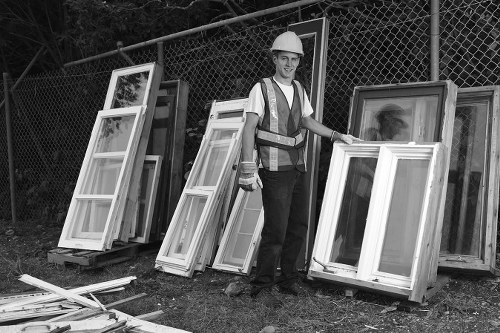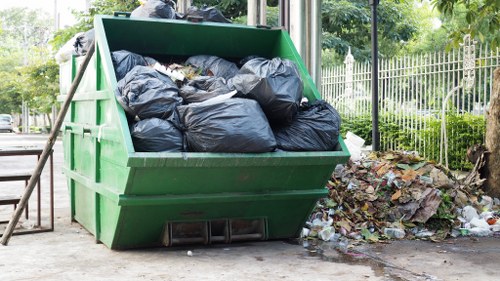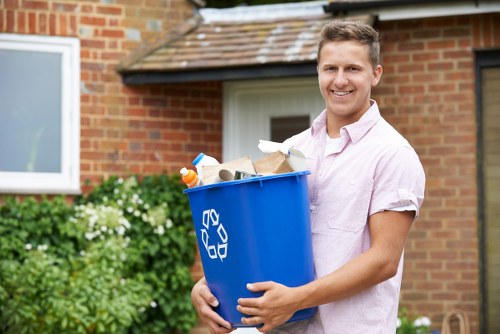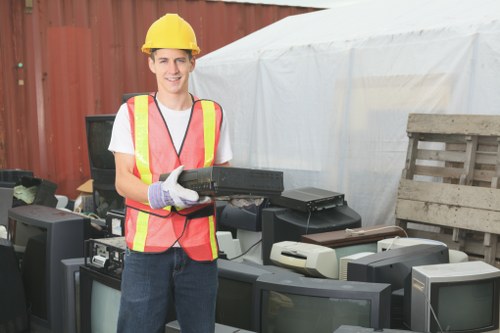Construction Waste Clearance in Pinner

Managing construction waste clearance in Pinner is essential for maintaining a clean and safe environment during and after any building project. Whether you’re undertaking a small home renovation or a large-scale construction project, effective waste management ensures compliance with local regulations and minimizes environmental impact.
Construction sites generate a significant amount of waste, including materials like concrete, wood, metals, and packaging. Proper disposal of these materials not only helps in reducing landfill usage but also promotes recycling and reuse, contributing to a more sustainable community in Pinner.
Choosing the right waste clearance service is crucial. A professional service will assess the volume and type of waste, provide appropriate containers, and ensure timely removal. This allows construction managers to focus on their projects without worrying about waste accumulation.

Benefits of Professional Waste Clearance
Engaging a professional construction waste clearance service in Pinner offers numerous advantages:
- Efficiency: Professionals can handle waste quickly and effectively, preventing site delays.
- Compliance: Ensures all waste is disposed of according to local regulations and environmental standards.
- Safety: Proper waste management reduces hazards on construction sites.
- Cost-Effective: Eliminates the need for renting multiple containers and managing waste internally.
These benefits not only streamline the construction process but also enhance the overall quality and sustainability of the project.
Moreover, professional services often have partnerships with recycling facilities, ensuring that a significant portion of the waste is repurposed rather than sent to landfills.

Types of Construction Waste
Understanding the different types of construction waste is important for effective clearance:
- Concrete and Masonry: Common in building foundations and structures.
- Wood and Timber: Used in framing, flooring, and cabinetry.
- Metals: Includes steel beams, aluminum, and other alloys.
- Plastics and Packaging: From materials like PVC and various packaging materials.
- Hazardous Waste: Includes asbestos, paints, and solvents that require special handling.
Proper categorization of waste types ensures that each material is handled appropriately, maximizing recycling efforts and minimizing environmental impact.
Different waste types may require separate containers or specialized removal processes, making professional guidance invaluable.

Steps for Effective Waste Clearance
Implementing an organized approach to waste clearance can enhance efficiency:
- Assessment: Evaluate the volume and types of waste generated.
- Planning: Develop a waste management plan outlining collection and disposal methods.
- Collection: Use appropriate containers and timely removal schedules.
- Disposal: Ensure waste is transported to approved facilities for recycling or disposal.
- Monitoring: Regularly review waste management practices to identify areas for improvement.
Following these steps helps maintain a clutter-free site and ensures that all waste is handled responsibly.
Additionally, regular monitoring allows for adjustments to the waste management plan as the project progresses.

Choosing the Right Waste Clearance Partner
Selecting a reliable waste clearance service in Pinner involves considering several factors:
- Experience: Look for companies with a proven track record in construction waste management.
- Licensing and Certification: Ensure the service is licensed and adheres to industry standards.
- Recycling Practices: Choose services that prioritize recycling and sustainable disposal methods.
- Customer Support: Good communication and responsive customer service are essential.
- Pricing: Compare quotes to find a service that offers value without compromising quality.
By carefully evaluating these aspects, you can partner with a service that aligns with your project’s needs and sustainability goals.
Investing in a reputable waste clearance partner ensures smooth project execution and contributes positively to the community and environment.
Environmental Impact of Construction Waste

Construction waste has a significant impact on the environment. Improper disposal can lead to soil contamination, water pollution, and increased greenhouse gas emissions. By implementing effective waste clearance practices, the environmental footprint of construction projects can be greatly reduced.
Recycling and Reuse: Many construction materials can be recycled or reused, reducing the need for new raw materials and conserving natural resources.
Minimizing Landfill Use: Efficient waste management reduces the volume of waste sent to landfills, prolonging their lifespan and decreasing land usage.
Regulations and Compliance

Adhering to local regulations is mandatory for construction waste clearance in Pinner. Non-compliance can result in hefty fines and project delays. Key regulations include proper sorting of waste, documentation of disposal methods, and adherence to environmental protection laws.
Permits and Licensing: Ensure that your waste clearance service holds the necessary permits and licenses to operate legally in Pinner.
Regular audits and inspections may be conducted to enforce compliance, making it essential to maintain high standards in waste management practices.
Cost Considerations

Effective construction waste clearance can be cost-effective in the long run. While there may be upfront costs associated with hiring a professional service, the savings from reduced landfill fees, avoidance of fines, and potential resale of recyclable materials can be substantial.
Budgeting: Incorporate waste management costs into your overall project budget to prevent unexpected expenses.
Comparing different service providers and understanding their pricing structures can help you find a solution that fits within your financial constraints.
Sustainability and Future Trends

The construction industry is increasingly focusing on sustainability. Future trends in waste clearance include greater emphasis on recycling, the use of eco-friendly materials, and innovative technologies for waste management. Embracing these trends can enhance the sustainability of construction projects in Pinner.
Green Building Practices: Incorporating green building practices reduces waste generation and promotes environmental responsibility.
Technological advancements, such as waste tracking software and automated sorting systems, are set to revolutionize construction waste management, making it more efficient and effective.
Conclusion

Effective construction waste clearance in Pinner is critical for the success and sustainability of any construction project. By partnering with professional waste management services, adhering to regulations, and embracing sustainable practices, construction projects can minimize their environmental impact and operate more efficiently.
Take Action Today! Don’t let construction waste hinder your project’s progress. Contact us today to schedule a waste clearance service that meets your needs and supports a greener Pinner.
Ensure your construction project is on the path to success with responsible and efficient waste management.
FAQs about Construction Waste Clearance in Pinner

1. What types of materials are typically removed during construction waste clearance?
Construction waste clearance involves removing materials like concrete, wood, metals, plastics, and sometimes hazardous materials such as asbestos and solvents.
2. How do I choose the right waste clearance service in Pinner?
Consider factors like the service provider’s experience, licensing, recycling practices, customer reviews, and cost to choose the right waste clearance service.
3. Is construction waste clearance required by law in Pinner?
Yes, adhering to local waste management regulations is mandatory. Failure to comply can result in fines and project delays.
4. Can construction waste be recycled?
Many construction materials, such as metals, wood, and concrete, can be recycled. Professional waste clearance services can facilitate the recycling process.
5. How often should waste be cleared from a construction site?
The frequency of waste clearance depends on the project’s scale and duration, but regular intervals help maintain a safe and efficient work environment.
Get Started with Your Waste Clearance Today

Don’t let construction waste become a burden on your project. Book your service now and ensure your construction site in Pinner remains clean, safe, and compliant with all regulations.
Our team of experts is ready to assist you with efficient and sustainable waste clearance solutions tailored to your project’s specific needs.
Take the first step towards a hassle-free construction experience by reaching out to us today!